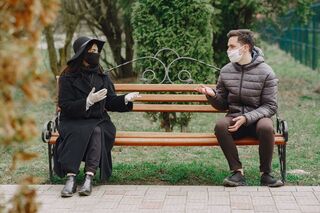Two years ago today, the World Health Organization officially declared COVID-19 to be a pandemic. Now, after two years of living with various restrictions, many of us are entering a new phase, with some long-neglected life options returning. We may be asking ourselves: “how do I want to live now?” As we wrestle with this question – aided by the greater perspective and wisdom that comes from adversity – we may benefit from considering what constitutes, for us, a good life.
Psychological scientists increasingly focus on three different visions of a good life.
First, a life of happiness tends to be characterized by pleasure, stability, and comfort. (On the flip side, a life of happiness seeks to minimize pain, instability, and discomfort.) Of course, we all find happiness in different ways, but research often shows how the experience of close relationships plays a vital role in this vision of a good life. For example, in a recent study, research participants rated having a party to be the daily activity most likely to make them happy. I’m also reminded of Elizabeth Gilbert’s quest for a good life in her bestselling book “Eat, Pray, Love,” and how her pursuit of pleasure translated for her to eating really good food in Italy. If we want to focus our lives on happiness, we might do well to habitually ask ourselves, “what would I most enjoy?”
A second vision for a good life involves the pursuit of meaning, characterized by purpose, coherence, and significance. (On the other hand, a life of meaning seeks to avoid aimlessness, fragmentation, and insignificance.) People living this kind of good life often feel like they are making the world somehow better. Religious and spiritual activities often play an important role. For instance, in “Eat, Pray, Love,” Elizabeth Gilbert sought a life of devotion through yoga and meditation in India. We can concentrate on this vision of a good life by consistently asking ourselves, “what would be most meaningful?”
Increasingly, psychologists of the good life discuss a third vision: a psychologically rich life. This kind of life comes with a variety of interesting experiences that produce changes in perspective. (The opposite of a psychologically rich life may be found in a lifestyle characterized by repetition, boredom, and stagnation.) Research shows how study abroad experiences in college, for example, tend to increase feelings of psychological richness. Live music, in-person art, and many other kinds of stimulating, mind-opening experiences may play a special role in nurturing a psychologically rich life as well. For those of us wanting to pursue this vision of a good life, we might do well to frequently ask ourselves, “what would be most interesting?”











 The pandemic is excruciating for many reasons, but it also contains great potential for new growth as well. In this time, we may gain an opportunity for insight into the dynamics of education and to better understand factors that help students thrive.
The pandemic is excruciating for many reasons, but it also contains great potential for new growth as well. In this time, we may gain an opportunity for insight into the dynamics of education and to better understand factors that help students thrive.